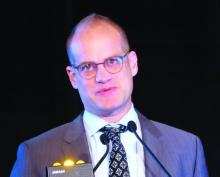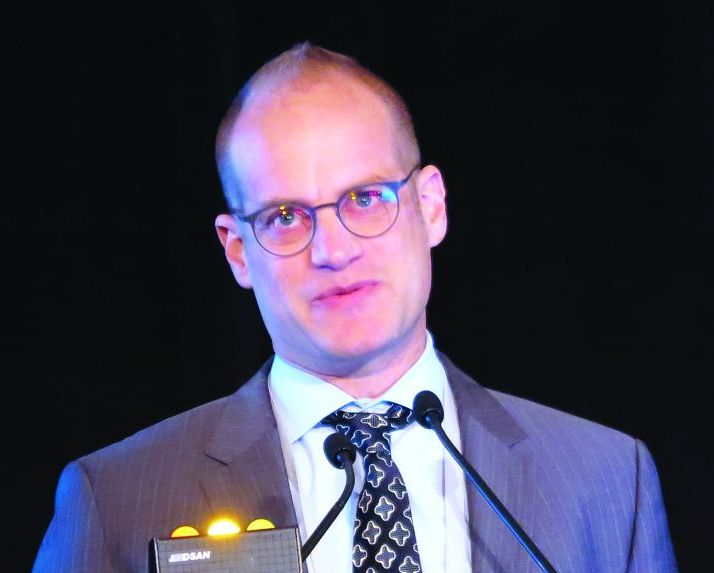User login
BOSTON – In San Francisco, a citywide program to get all persons with newly diagnosed HIV infections linked to care within 5 working days cut the time to first virologic suppression by more than half and reduced the median time from initiation of care to antiretroviral therapy from nearly 4 weeks to just 1 day, an infectious disease specialist reported.
“We saw significant improvements in time to ART [antiretroviral therapy] initiation and time to first virologic suppression in traditionally vulnerable populations, including racial and ethnic minorities and the homeless. However, disparities remain in some groups,” Oliver Bacon, MD, MPH, of the University of California, San Francisco, and the San Francisco Department of Public Health, said at the Conference on Retroviruses and Opportunistic Infections.
Under the program, all persons with confirmed HIV diagnoses are linked within 5 working days to care, and at the first care visit, have baseline labs collected, receive counseling, and undergo medical and psychosocial assessment. Patients then begin ART with tenofovir and emtricitabine plus either an integrase inhibitor or a boost of darunavir, with the option of a four-drug regimen if the HIV infection was suspected to have occurred while the patient was taking preexposure prophylaxis.
The investigators identified HIV clinics using HIV surveillance data, and trained providers on RAPID procedures with both in-service training and individual provider detailing.
Providers and clinics that agreed to join the program were added to a RAPID provider directory, which was then given to linkage navigators that could use it to identify the optimal HIV clinic for each newly diagnosed patient, according to insurance coverage and psychosocial needs.
The full protocol and RAPID detailing brochure also were made available to clinicians at a website and were distributed at open quarterly consortium meetings.
Dr. Bacon presented HIV case registry data on care outcomes from 2013 to 2016.
In 2013, 93% of all new HIV cases linked to care; in 2016, 97% linked. The proportion of newly diagnosed persons who started on ART also improved, from 78% in 2013 to 81% in 2016. In addition, the proportion of patients who both linked to care within 5 days and were started on ART within 1 day rose from 6% in 2013 to 30% by 2016.
Similar improvements were seen in median time from diagnosis to care, from 8 days in 2013 to 5 in 2016 (–38%); time from the first care visit to ART initiation from 27 days to 1 day, respectively (–96%); time from ART initiation to virologic load below 200 copies/mL from 70 to 38 days (–46%), and time from diagnosis to virologic load below 200 from 134 to 61 days (–54%).
Time from diagnosis to first care visit decreased significantly for males, whites, Hispanics, youth aged 13-29 years, and for those with housing; time from ART to virologic suppression decreased significantly for males, those under age 40 years, whites, Hispanics, Asian/Pacific Islanders, and for those with housing.
It is important to note that 16% of persons diagnosed with HIV in 2016 had not started on ART. “We found no notable sociodemographic differences versus the ART starters, although we did not look at mental illness [or] ... substance use,” Dr. Bacon said.
He acknowledged that the analysis did not address the important question of durability of virologic suppression.
The San Francisco Getting to Zero Consortium is sponsored by Gilead, Janssen, Bristol-Myers Squibb, the City of San Francisco, and by Will Hagerty. Dr. Bacon reported no conflicts of interest to disclose.
SOURCE: Buchbinder SP et al. CROI 2018, Abstract 87.
BOSTON – In San Francisco, a citywide program to get all persons with newly diagnosed HIV infections linked to care within 5 working days cut the time to first virologic suppression by more than half and reduced the median time from initiation of care to antiretroviral therapy from nearly 4 weeks to just 1 day, an infectious disease specialist reported.
“We saw significant improvements in time to ART [antiretroviral therapy] initiation and time to first virologic suppression in traditionally vulnerable populations, including racial and ethnic minorities and the homeless. However, disparities remain in some groups,” Oliver Bacon, MD, MPH, of the University of California, San Francisco, and the San Francisco Department of Public Health, said at the Conference on Retroviruses and Opportunistic Infections.
Under the program, all persons with confirmed HIV diagnoses are linked within 5 working days to care, and at the first care visit, have baseline labs collected, receive counseling, and undergo medical and psychosocial assessment. Patients then begin ART with tenofovir and emtricitabine plus either an integrase inhibitor or a boost of darunavir, with the option of a four-drug regimen if the HIV infection was suspected to have occurred while the patient was taking preexposure prophylaxis.
The investigators identified HIV clinics using HIV surveillance data, and trained providers on RAPID procedures with both in-service training and individual provider detailing.
Providers and clinics that agreed to join the program were added to a RAPID provider directory, which was then given to linkage navigators that could use it to identify the optimal HIV clinic for each newly diagnosed patient, according to insurance coverage and psychosocial needs.
The full protocol and RAPID detailing brochure also were made available to clinicians at a website and were distributed at open quarterly consortium meetings.
Dr. Bacon presented HIV case registry data on care outcomes from 2013 to 2016.
In 2013, 93% of all new HIV cases linked to care; in 2016, 97% linked. The proportion of newly diagnosed persons who started on ART also improved, from 78% in 2013 to 81% in 2016. In addition, the proportion of patients who both linked to care within 5 days and were started on ART within 1 day rose from 6% in 2013 to 30% by 2016.
Similar improvements were seen in median time from diagnosis to care, from 8 days in 2013 to 5 in 2016 (–38%); time from the first care visit to ART initiation from 27 days to 1 day, respectively (–96%); time from ART initiation to virologic load below 200 copies/mL from 70 to 38 days (–46%), and time from diagnosis to virologic load below 200 from 134 to 61 days (–54%).
Time from diagnosis to first care visit decreased significantly for males, whites, Hispanics, youth aged 13-29 years, and for those with housing; time from ART to virologic suppression decreased significantly for males, those under age 40 years, whites, Hispanics, Asian/Pacific Islanders, and for those with housing.
It is important to note that 16% of persons diagnosed with HIV in 2016 had not started on ART. “We found no notable sociodemographic differences versus the ART starters, although we did not look at mental illness [or] ... substance use,” Dr. Bacon said.
He acknowledged that the analysis did not address the important question of durability of virologic suppression.
The San Francisco Getting to Zero Consortium is sponsored by Gilead, Janssen, Bristol-Myers Squibb, the City of San Francisco, and by Will Hagerty. Dr. Bacon reported no conflicts of interest to disclose.
SOURCE: Buchbinder SP et al. CROI 2018, Abstract 87.
BOSTON – In San Francisco, a citywide program to get all persons with newly diagnosed HIV infections linked to care within 5 working days cut the time to first virologic suppression by more than half and reduced the median time from initiation of care to antiretroviral therapy from nearly 4 weeks to just 1 day, an infectious disease specialist reported.
“We saw significant improvements in time to ART [antiretroviral therapy] initiation and time to first virologic suppression in traditionally vulnerable populations, including racial and ethnic minorities and the homeless. However, disparities remain in some groups,” Oliver Bacon, MD, MPH, of the University of California, San Francisco, and the San Francisco Department of Public Health, said at the Conference on Retroviruses and Opportunistic Infections.
Under the program, all persons with confirmed HIV diagnoses are linked within 5 working days to care, and at the first care visit, have baseline labs collected, receive counseling, and undergo medical and psychosocial assessment. Patients then begin ART with tenofovir and emtricitabine plus either an integrase inhibitor or a boost of darunavir, with the option of a four-drug regimen if the HIV infection was suspected to have occurred while the patient was taking preexposure prophylaxis.
The investigators identified HIV clinics using HIV surveillance data, and trained providers on RAPID procedures with both in-service training and individual provider detailing.
Providers and clinics that agreed to join the program were added to a RAPID provider directory, which was then given to linkage navigators that could use it to identify the optimal HIV clinic for each newly diagnosed patient, according to insurance coverage and psychosocial needs.
The full protocol and RAPID detailing brochure also were made available to clinicians at a website and were distributed at open quarterly consortium meetings.
Dr. Bacon presented HIV case registry data on care outcomes from 2013 to 2016.
In 2013, 93% of all new HIV cases linked to care; in 2016, 97% linked. The proportion of newly diagnosed persons who started on ART also improved, from 78% in 2013 to 81% in 2016. In addition, the proportion of patients who both linked to care within 5 days and were started on ART within 1 day rose from 6% in 2013 to 30% by 2016.
Similar improvements were seen in median time from diagnosis to care, from 8 days in 2013 to 5 in 2016 (–38%); time from the first care visit to ART initiation from 27 days to 1 day, respectively (–96%); time from ART initiation to virologic load below 200 copies/mL from 70 to 38 days (–46%), and time from diagnosis to virologic load below 200 from 134 to 61 days (–54%).
Time from diagnosis to first care visit decreased significantly for males, whites, Hispanics, youth aged 13-29 years, and for those with housing; time from ART to virologic suppression decreased significantly for males, those under age 40 years, whites, Hispanics, Asian/Pacific Islanders, and for those with housing.
It is important to note that 16% of persons diagnosed with HIV in 2016 had not started on ART. “We found no notable sociodemographic differences versus the ART starters, although we did not look at mental illness [or] ... substance use,” Dr. Bacon said.
He acknowledged that the analysis did not address the important question of durability of virologic suppression.
The San Francisco Getting to Zero Consortium is sponsored by Gilead, Janssen, Bristol-Myers Squibb, the City of San Francisco, and by Will Hagerty. Dr. Bacon reported no conflicts of interest to disclose.
SOURCE: Buchbinder SP et al. CROI 2018, Abstract 87.
REPORTING FROM CROI
Key clinical point: A program for getting newly diagnosed HIV cases into care and treatment rapidly improved clinical outcomes, including among vulnerable populations.
Major finding: Median time from the first care visit to antiretroviral therapy initiation decreased from 27 days to only 1.
Study details: A retrospective analysis of outcomes from the Rapid ART Program Initiative for HIV Diagnoses.
Disclosures: The San Francisco Getting to Zero Consortium is sponsored by Gilead, Janssen, Bristol-Myers Squibb, the City of San Francisco, and by Will Hagerty. Dr. Bacon disclosed no conflicts of interest.
Source: Buchbinder SP et al. CROI 2018, Abstract 87.

